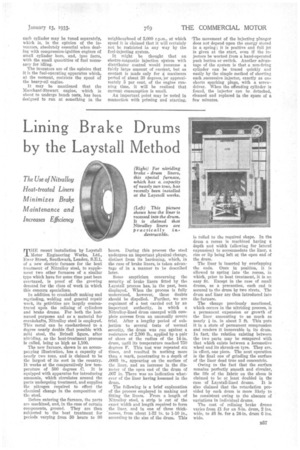Lining Brake Drums by the Laystall Method
Page 51

If you've noticed an error in this article please click here to report it so we can fix it.
THE recent installation by Laystall Motor Engineering Works, Ltd., Ewer Street, Southwark, London, S.E.1, of a new electric furnace for the heat treatment of Nitralloy steel, to supplement two other furnaces of a similar type which have for some time past been overtaxed, is proof of the growing demand for the class of work in which this concern specializes.
In addition to crankshaft making and regrinding, welding and general repair work, its activities are largely c.oneetttraced upon the relining of cylinders and brake drums. For both the lastnamed purposes and as a material for crankshafts, Nitralloy steel is employed. This metal can be casehardened to a degree nearly double that possible with mild steel, the Brinell figure, after nitriding, as the heat-treatment process is called, being as high as 1,100.
The new furnace, shown in an accompanying illustration, has a capacity of nearly two tons, and is claimed to be the largest of its sort in the country. It works at the comparatively low temperature of 500 degrees .C. It is equipped with apparatus for introducing ammonia, which circulates around the parts undergoing treatment, and supplies the nitrogen required to effect the chemical change in the composition of the steel.
Before entering the furnace, the parts are machined, and, in the case of certain components, ground. They are then subjected to the beat treatment for periods varying from 50 hours to 90
hours. During this process the steel undergoes an important physical change, distinct from its hardening, which, in the case of brake liners, is taken advantage of in a manner to be described later.
Some scepticism concerning the security of brake liners fitted by the Laystall process has, in the past, been displayed. When the process is fully understood, however, these doubts should be dispelled. Further, we are cognizant of a test carried out by an important authority, in which a Nitralloy-lined drum emerged with complete success from an unusually severe trial. After a lengthy period of subjection to several tests of normal severity, the drum was run against a resistance of 2,300 lb., applied by a pair of shoes at the radius of the 14-in. drum, until its temperature reached 750 degrees F. This test was repeated six times, and resulted in nothing more than a mark, penetrating to a depth of .0005 in., appearing on the surface of the liner, and an increase in the diameter of the open end of the drum of .007 in. There was no indication whatever of the liner having loosened in the drum.
The following is a brief explanation of the process employed in making and fitting the liners. From a length of Nitralloy steel, a strip is cut of the exact width and length required to form the liner, and in one of three thicknesses, from about 1-32 in. to 1-10 in., according to the size of the drum. This is rolled to the required shape. In the drum a recess is machined having a depth and width (allowing for lateral expansion) to accommodate the liner, a rim or lip being left at the open end of the drum.
The liner is inserted by overlapping the ends. Once in position, it is allowed to spring into the recess, in which, prior to heat treatment, it is an easy fit. Except in the case of small drums, as a precaution, each end is secured to the drum by two rivets. The drum and liner are then introduced into the furnace.
The change previously mentioned, which occurs in the nitriding process, is a permanent expansion or growth of the liner amounting to as much as nearly in. in about 3 ft. This puts it in a state of permanent compression and renders it immovable in its drum, In fact, the relation existing between the two parts may be compared With that which exists between a locomotive wheel and its shrunk-on tyre. They are, in effect, one piece. The next operation is the final one of grinding the surface of the liner dead true and concentric.
Owing to the fact that the surface remains perfectly smooth and circular, the life of the fabric on the shoes is claimed to be at least doubled in the case of Laystall-lined drums. It is also claimed that the retardation provided by each drum is more likely to be consistent owing to the absence of variations in individual drums.
The cost of relining brake drums varies from /1 for an 8-in. drum, 2 ins. wide, to £6 as. for a 24-in. drum 6 ins. wide.




























































































